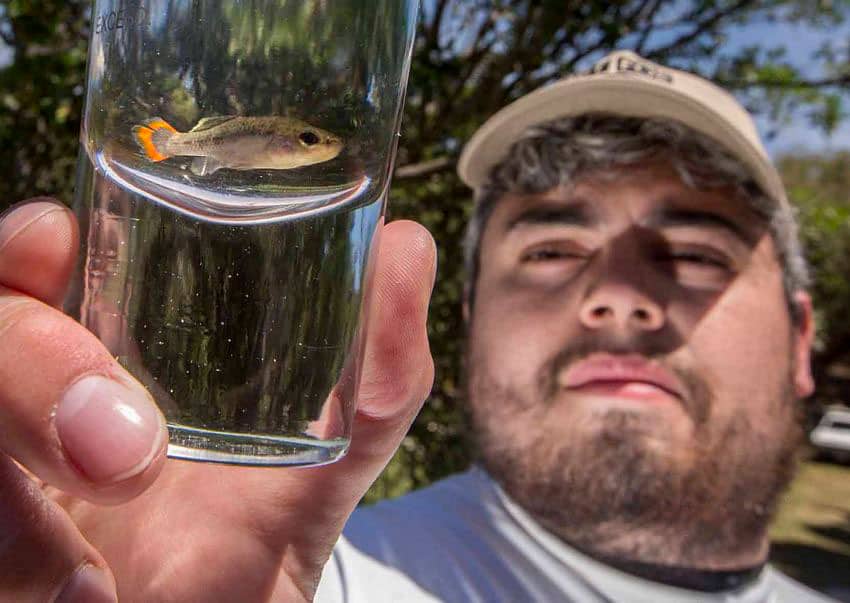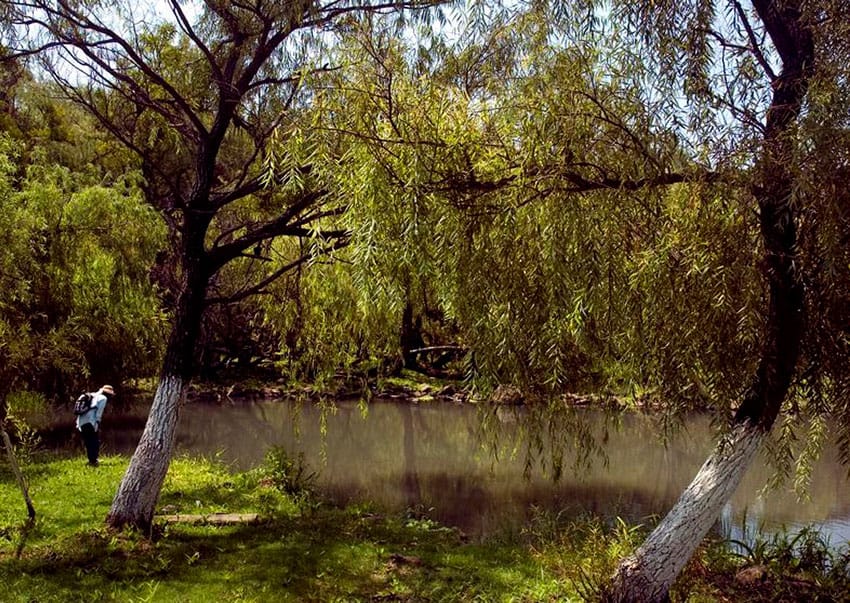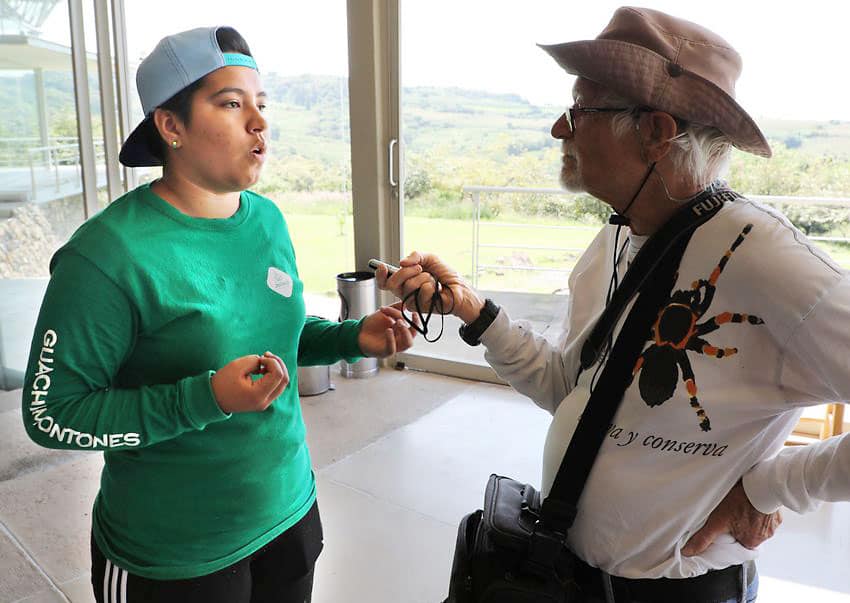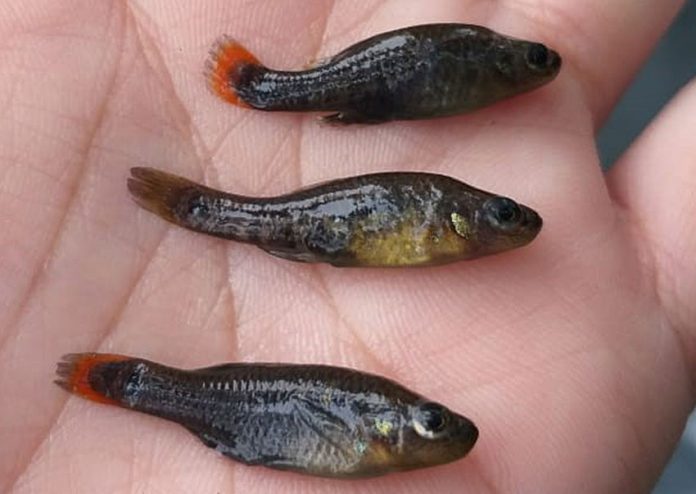Crystal-clear water bubbles up out of the ground just below the archaeological ruins of western Mexico’s circular pyramids, the Guachimontones.
This spot, known as El Rincón, is the birthplace of the Teuchitlán river, which flows for all of one kilometer only to disappear into La Vega Dam, a Ramsar Site (wetland of international importance) since 2010.
Long ago, for her own reasons, Mother Nature sprinkled into that short stretch of river several species of curious little fish called splitfins or Goodeids, typically only five centimeters (two inches) long.
These fish are unusual because they are viviparous: instead of laying eggs, they give birth to their young alive. The females actually have something similar to a uterus and the babies receive nutrition from their mothers via an umbilical-like cord called a trophotaenia.
Somehow British fish fanciers heard about the livebearers of the Teuchitlán river, came to see for themselves, and carried off pairs of them to breed far, far from their homeland.

One of the species from Teuchitlán, the butterfly splitfin (Ameca splendens), particularly fascinated them because its favorite food turned out to be algae. It was the perfect choice to keep an aquarium clean — and it was indeed as cute as a butterfly — so in no time at all fish fanciers were breeding it all over the world.
Try Googling Ameca splendens in the most exotic languages you can think of and see how many results you get!
In time, unfortunately, the Teuchitlán river suffered from pollution and the introduction of invasive species. Rumors circulated that the butterfly splitfin had vanished, but eventually biologist José Luis Zavala found small numbers of them still breeding in a few private pools owned by restaurants along lake La Vega.
Then, in 1997, British livebearer enthusiast Ivan Dibble attended a symposium in Cuernavaca where it was demonstrated that several other species of splitfins really had gone extinct in their native habitat near the Teuchitlán river.
Here is where the idea of creating a Fish Ark in Mexico occurred to Dibble. “I have almost always risen to a challenge,” said the Englishman.
He flew off to England but, true to his word, returned to Mexico a few months later with two species of Goodeids now considered extinct locally: the tequila splitfin (Zoogoneticus tequila) and the golden skiffia (Skiffia francesae), both of which were soon reproducing happily in the aquatic biology lab of the University of Michoacán, in Morelia, the oldest institution of higher education in the Americas (founded in 1540).

From this point on, aquaria hobbyists have regularly contributed funds to keep this Fish Ark going.
Years passed, but the idea of returning these little fish to their native habitat never died. In 2018, while camping near the Teuchitlán river, I bumped into Rubén Hernández, a biologist at the lab in Morelia. He told me he was in Jalisco working on a project to reintroduce the tequila splitfin into the springs of Teuchitlán.
I was quite delighted to find out that the University of Michoacán’s co-sponsors in the project were the Chester Zoo in Cheshire, England, the Mohammed bin Zayed Species Conservation Fund operating out of Abu Dhabi and 11 other organizations located in Austria, Denmark, Holland, Germany, France, the United Kingdom, the Czech Republic, Mexico and the United States. The eyes of the world, it seemed, were on Jalisco’s little splitfins.
Since then, this project to “bring back the dead” has been moving along nicely. A few days ago conservationist Manfred Meiners took me to the springs of El Rincón, where the Teuchitlán river is born, to watch the Morelia lab people at work.
I found biologist Arely Ramírez checking one of a dozen basket-like fish traps which she and her fellow researchers had set in two spring-fed ponds.
“This project started in 2015,” she told me, “under Dr. Omar Domínguez of the University of Michoacán. In the first year we studied all the variables of the springs and rivers around here: what species live in this site and how they might behave once we would have them interacting with the tequila splitfin. We looked at water quality, temperature, oxygen and all the environmental variables along the river.

“We studied each species of the local community of fish: what they eat, how they reproduce and what parasites they have. Finally we introduced Zoogoneticus into two pools, one natural and one artificial here at Balneario El Rincón. Since then we have been studying them carefully and I’m happy to say they are doing fine.”
I was amazed to learn that every one of the 3,000 fish which the biologists introduced into these waters four years ago had been specially marked so it could be identified as an individual. This is achieved by “tattooing” each fish with a series of tiny dots of color, all in a line. Each sequence of colors is different and each can be instantly identified by a special scanner that looks much like a little flashlight.
“Every time we come here,” Ramírez told me, “we check to see whether the fish we find are from the batch we originally introduced or are their descendants. You may be surprised to learn that these days most of the fish we’re looking at are completely unmarked. They’re almost all from new generations, and looking very healthy.”
I also learned that the team from Michoacán has deeply involved the local people in this project. School children learn all about their world-famous little fish and town officials cooperate in regular projects to clean up the river and to monitor water quality.
I found one of those water monitors working at the Teuchitlán Interactive Museum. “I was in prep school,” Monserrat Íñiguez told me, “when I began to hear that in our own river we had fish that were unique in all the world and that lots of people, even foreigners, were worried about them and were actually spending money to preserve those fish.
“Then it was announced that they would be giving a course about out local animals, plants and environment and I thought, ‘I need to support this; we should be taking care of what nature has given us.’ Well, the course was for adults, but they let me in anyway, and we learned so much! We learned how to care for the river so these fish can keep living in it and they taught us how to monitor the water quality.
[soliloquy id="92616"]
“We learned to measure air and water temperature, wind speed, alkalinity, etc. using techniques that were easy to do and understand even if you weren’t a scientist. As a result of all this, I decided to change my career from nutrition to biology. Right now I can’t afford to go back to school, but I’m working here at the museum and saving up, because a biologist is what I want to be!”
According to the United Nations World Conservation Monitoring Center, Mexico’s Central Mesa is considered one of the most important places in the world for the conservation of freshwater fish. It seems the number of species in Mexico alone is almost as great as those of the U.S. and Canada combined.
And those of us who live on that Central Mesa know that the problem of water pollution here is way beyond bad. We owe a debt of gratitude to the hobbyists and biologists in Mexico and around the world, who are now working together to bring the dead back to life in the tiny Teuchitlán river.
The writer has lived near Guadalajara, Jalisco, for more than 30 years and is the author of A Guide to West Mexico’s Guachimontones and Surrounding Area and co-author of Outdoors in Western Mexico. More of his writing can be found on his website.
